 The 32 insurance markets reviewed by the current edition of XPRIMM Insurance Report recorded a premium production of about EUR 36.7 billion in 1H2012, up by about 6% y-o-y, a meritorious result considering they were once again challenged by the weak economic and uncertain environment. The macroeconomic constraints translated into a generalized governmental eagerness to cut public debt and budgetary deficits which, in turn, brought further austerity measures resulting in a prolonged decrease of the public and private spending, also meaning lower corporate budgets and household allocations for insurance. Voluntary non-life insurance lines and life insurance were the most affected lines. Moreover, the volatile economic environment also affected the financial investment results, putting an additional strain on insurers' profitability and on public's appetite for saving via life insurance products, except for those providing some sort of warranty.
The 32 insurance markets reviewed by the current edition of XPRIMM Insurance Report recorded a premium production of about EUR 36.7 billion in 1H2012, up by about 6% y-o-y, a meritorious result considering they were once again challenged by the weak economic and uncertain environment. The macroeconomic constraints translated into a generalized governmental eagerness to cut public debt and budgetary deficits which, in turn, brought further austerity measures resulting in a prolonged decrease of the public and private spending, also meaning lower corporate budgets and household allocations for insurance. Voluntary non-life insurance lines and life insurance were the most affected lines. Moreover, the volatile economic environment also affected the financial investment results, putting an additional strain on insurers' profitability and on public's appetite for saving via life insurance products, except for those providing some sort of warranty.The Central and East European (CEE) region comprises 17 countries, of which 10 are EU members, with fairly developed insurance markets. Except for Croatia, the non-EU countries of the region have young, emerging insurance markets, currently going through a transition period for which the main target remains the compliance with the European standards and practices. The first half of 2012 ended for the CEE markets with a consolidate GWP figure of EUR 17.7 billion, almost unchanged as compared to 1H2011. Paid claims amounted for EUR 10.07 billion, 3.5% less y-o-y. The overall dynamic needs yet a careful consideration, as the strong depreciation of some of the national currencies during the last 12 months had a negative impact on the markets results denominated in European currency. Hungary, Poland, Romanian and Serbia are the most relevant examples in this respect. Thus, aiming to get a more accurate picture of the regional dynamic, we have weighted national growth rates with corresponding regional market shares of each country. The result shows an about 5.3% CEE growth rate, when considering each market's evolution in its own currency. On the claims side, a similar operation shows a 2.6% decrease of the claims expenses in local currency.
Disregarding the currency influence, Poland and Estonia are the only markets recalling the "traditional" double-digit growth rates, once defining the entire region, with 1H2012 premium figures higher by 12.6% and 11.4% respectively, as compared to the 1H2011 results. Serbia, Romania, Montenegro, Macedonia, Latvia, Bosnia&Herzegovina and Kosovo have also recorded, at a lower extent, positive evolutions of their GWP volumes. For some of them, however, the currency conversion has pushed results in the negative zone.
As far as the regional market share is concerned, 1H2012 brought no major changes. Poland's leadership position not only that remained unchallenged, but but even strengthened by gaining 3pp, up to 44%. Czech Republic and Hungary rank second and third, both of them loosing about 1pp of their respective market shares, to 17.8% and 8%. No other country recorded a significant change of its weight in the regional market.
Greece, Cyprus and Turkey form the group of South East European countries analyzed, and accounted together for a GWP volume of EUR 6.89 billion, 6.5% higher y-o-y. By far, Turkey was the SEE champion, with a 12.75% growth rate in national currency (16% denominated in EUR) and a total GWP reaching EUR 4.42 billion. At the same time, the Greek insurance market still remained challenged by the economic crisis hardships, recording a negative change in GWP of 7.8%, to EUR 2.25 billion.
Looking at the 1H2012 results recorded by the 12 ex-soviet countries integrated in the Commonwealth of Independent States - CIS , the most impressive issue, a real catch eye for any analyst, is that of the exceptional growth rates recorded by some of the very young markets in the region. Double-digit rates exceeding 50%, or even attempting to reach 100% (in EUR) were rarely seen even in the CEE markets' infancy. Moreover, although this rates usually belong to very small markets in absolute terms, they are a realistic confirmation of the region's tremendous potential.
All in all, the CIS market recorded EUR 12.1 billion in GWP and an average growth rate of almost 19%. Undisputed, Russia is by far the largest market in the region, accounting for more than 80% of the premium production, not only because of its dimensions, but also because of its development degree and sophistication, as compared to the other markets in the region.
Expectations for the 2012 year end are hardly optimistic, mostly depending on the future overall economic status of the region. In short, the eurozone's future is vital for the emerging CEE and CIS economies and, by extension, for their insurance markets well being.
Click here for the full version of the CEE, SEE and CIS 1H2012 overview.
Table: CEE, SEE & CIS market indicators in local currency
2492 views


